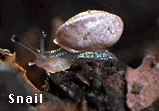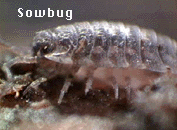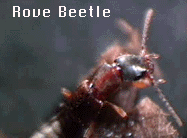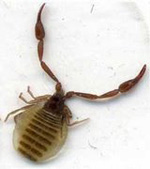Invertebrates of the Compost Pile
This is an excellent article from the Cornell Waste Management Web Site.
I don’t know about you, but it makes me want to run right out and see how many of these invertebrates I can find in my compost heap.
Invertebrates of the Compost Pile
Written by Nancy Trautmann, Cornell Center for the Environment
In small-scale outdoor composting systems, such as backyard compost piles, soil invertebrates are likely to contribute to the decomposition process. Together with bacteria, fungi, and other microbes, these organisms make up a complex food web or energy pyramid with primary, secondary, and tertiary level consumers. The base of the pyramid, or energy source, is made up of organic matter including plant and animal residues.
Tertiary Consumers
(organisms that eat secondary consumers)
centipedes, predatory mites,
rove beetles, fomicid ants,
carabid beetles
Secondary Consumers
(organisms that eat primary consumers)
springtails, some types of mites, feather-winged beetles
nematodes, protozoa, rotifera, soil flatworms
Primary Consumers
(organisms that eat organic residues)
bacteria, fungi, actinomycetes,
nematodes, some types of mites, snails, slugs,
earthworms, millipedes, sowbugs, whiteworms
Organic Residues
leaves, grass clippings, other plant debris,
food scraps,
fecal matter and animal bodies including those of soil invertebrates
Organic residues such leaves or other plant materials are eaten by some types of invertebrates such as millipedes, sow bugs, snails and slugs. These invertebrates shred the plant materials, creating more surface area for action by fungi, bacteria, and actinomycetes (a group of organisms intermediate between bacteria and true fungi), which are in turn eaten by organisms such as mites and springtails.
Many kinds of worms, including earthworms, nematodes, red worms and potworms eat decaying vegetation and microbes and excrete organic compounds that enrich compost. Their tunneling aerates the compost, and their feeding increases the surface area of organic matter for microbes to act upon. As each decomposer dies or excretes, more food is added to web for other decomposers.
Nematodes: These tiny, cylindrical, often transparent microscopic worms are the most abundant of the physical decomposers – a handful of decaying compost contains several million. It has been estimated that one rotting apple contains 90,000. Under a magnifying lens they resemble fine human hair. 
Some species scavenge on decaying vegetation, some feed on bacteria, fungi, protozoa and other nematodes, and some suck the juices of plant roots, especially root vegetables.
Mites: Mites are the second most common invertebrate found in compost. They have eight leg-like jointed appendages. Some can be seen with the naked eye and others are microscopic. Some can be seen hitching rides on the back of other faster moving invertebrates such as sowbugs, millipedes and beetles. Some scavenge on leaves, rotten wood, and other organic debris. Some species eat fungi, yet others are predators and feed on nematodes, eggs, insect larvae and other mites and springtails. Some are both free living and parasitic. One very common compost mite is globular in appearance, with bristling hairs on its back and red-orange in color.


Springtails: Springtails are extremely numerous in compost. They are very small wingless insects and can be distinguished by their ability to jump when disturbed. They run in and around the particles in the compost and have a small spring-like structure under the belly that catapults them into the air when the spring catch is triggered. They chew on decomposing plants, pollen, grains, and fungi. They also eat nematodes and droppings of other arthropods and then meticulously clean themselves after feeding.
Earthworms: Earthworms do the lion’s share of the decomposition work among the larger compost organisms. They are constantly tunneling and feeding on dead plants and decaying insects during the daylight hours. Their tunneling aerates the compost and enables water, nutrients and oxygen to filter down. “As soil or organic matter is passed through an earthworm’s digestive system, it is broken up and neutralized by secretions of calcium carbonate from calciferous glands near the worm’s gizzard. Once in the gizzard, material is finely ground prior to digestion. Digestive intestinal juices rich in hormones, enzymes, and other fermenting substances continue the breakdown process. The matter passes out of the worm’s body in the form of casts, which are the richest and finest quality of all humus material. Fresh casts are markedly higher in bacteria, organic material, and available nitrogen, calcium, magnesium, phosphorus and potassium than soil itself.” (Rodale)

Slugs and snails (left): Slugs and snails generally feed on living plant material but will attack fresh garbage and plant debris and will therefore appear in the compost heap.


Centipedes (right): Centipedes are fast moving predators found mostly in the top few inches of the compost heap. They have formidable claws behind their head which possess poison glands that paralyze small red worms, insect larvae, newly hatched earthworms, and arthropods – mainly insects and spiders.
Millipedes: They are slower and more cylindrical than centipedes and have two pairs of appendages on each body segment. They feed mainly on decaying plant tissue but will eat insect carcasses and excrement.
Sow Bugs (right): Sow Bugs are fat bodied crustaceans with delicate plate-like gills along the lower surface of their abdomens which must be kept moist. They move slowly grazing on decaying vegetation.

Beetles (left): The most common beetles in compost are the rove beetle, ground beetle and feather-winged beetle. Feather-winged beetles feed on fungal spores, while the larger rove and ground beetles prey on other insects, snails, slugs and other small animals.

Ants: Ants feed on aphid honey-dew, fungi, seeds, sweets, scraps, other insects and sometimes other ants. Compost provides some of these foods and it also provides shelter for nests and hills. Ants may benefit the compost heap by moving minerals especially phosphorus and potassium around by bringing fungi and other organisms into their nests.
Flies: During the early stages of the composting process, flies provide ideal airborne transportation for bacteria on their way to the pile. Flies spend their larval phase in compost as maggots, which do not survive thermophilic temperatures. Adults feed upon organic vegetation.
Spiders: Spiders feed on insects and other small invertebrates.
Pseudoscorpions: Pseudoscorpions are predators which seize victims with their visible front claws, then inject poison from glands located at the tips of the claws. Prey include minute nematode worms, mites, larvae, and small earthworms.

Earwigs: Earwigs are large predators, easily seen with the naked eye. They move about quickly. Some are predators. Others feed chiefly on decayed vegetation.

9 Responses
That is a long highly technical and long. How do you know so much? I very rarely run across people who cover a subject so thoroughly .Very interesting. Nice theme.
Perfect language skills too.
Thanks for your comments Danny. 😀
Wow, that was fascinating! Now I know why my compost has so many critters in it. I had no idea that they all had a purpose there. The ants particularly interested me since we had that problem of biting ants in the compost and weren’t sure whether or not to put the soil in the garden. Since they didn’t mention it, I guess we did the right thing since they are expected to be in compost. But we’ll see for sure when we work in our garden and if it’s a nightmare because of biting ants or not.
Thanks for the info,
Naomi
Thanks for your comment Naomi. You and I are doing a similar experiment at the same time. I have a freshly composted bed, ready for planting, and I am trying this no dig kind of gardening. I am not therefore turning this soil before planting into it. I did scrape a few weed starts off of the surface, and when I did that I saw fire ants everywhere. I planted seeds and transplants right into that bed anyway, and I am going to have to wait and see what happens. Stay in touch about your garden experiences. We appreciate your comments! 😀
I have loads of flies and maggots in my closed composter. When it warms above freezing, I like to leave the composter open. It seems to me that this is helpful for decomposition. However, as I’ve said to you before, I’m not doing enough with this closed composter to get the decomposition process going quickly.
Thanks for posting this great article.
Thanks for your comment Ethan. I learned from our conversation earlier that you know your little composter has an unbalanced ration of carbon to nitrogen. The ratio should be carbon 4 or 5 parts to 1 part of nitrogen. More carbonaceous products..like your excellent autumn leaves will help with those maggots as well as any smells coming out of there, and help turn your kitchen garbage to beautiful compost. Best of luck to you.
HI ADINA,great articles on composting,myself im a composting nut,always collecting compost material,just hauled 8 truck loads of bunny poop, I have just a small garden ,but i have been building raised beds for neighbors, not many GA gardeners i know of have raised beds,this clay soil not clay when i get through with it, i had okra plants if not world records veryyyyy close,11 ft tall 3 or 4 inches round, had to cut them down with a saw roots veryyy deep, someday if i win lottery would like to plant all of GA ORGANIC, GIVE ALL THE FOOD TO HOMELESS SHELTERS, but thanks SOOOOO MUCH for all your onfo on gardening, may god bless you, keep u healthy to garden for as long as u like,tu BOBBY
Hey Bobby, thanks so much for your comment. I know about that GA clay. On the bright side I hear y’all don’t need a pond liner to hold the water in your ponds. Isn’t it excellent how raised beds work with rocky, clayey, or sandy soil just the same? Best of luck to you in your garden and for your generous plans for the future.